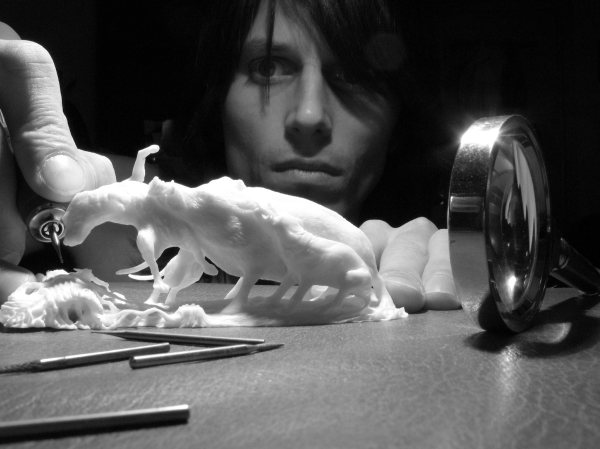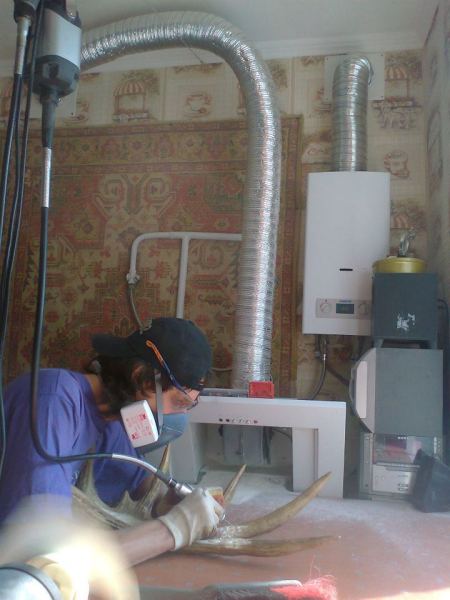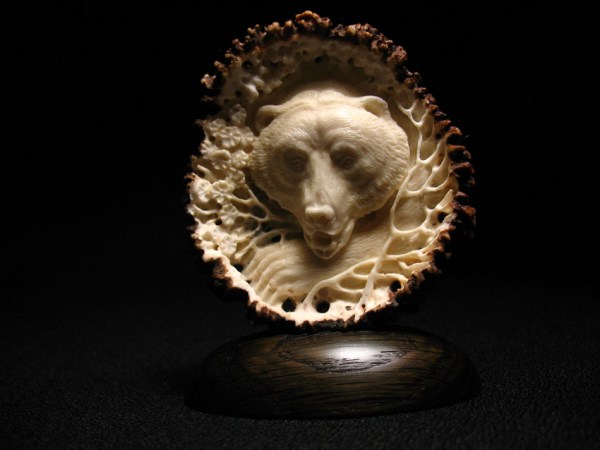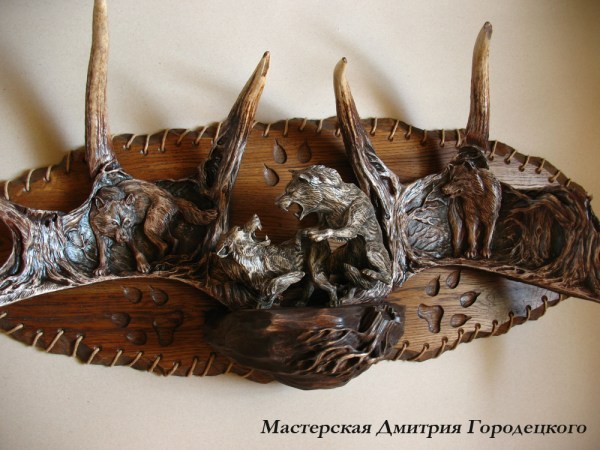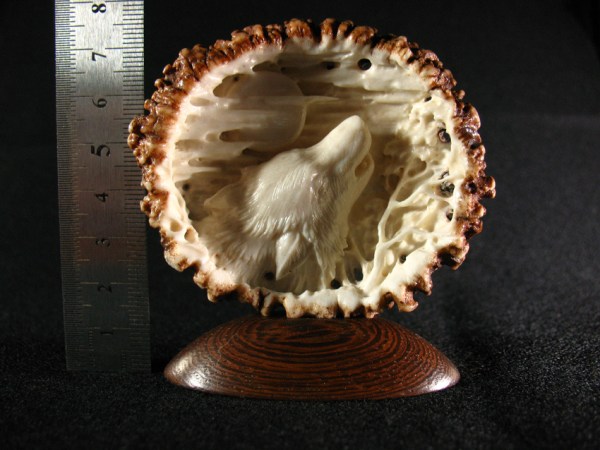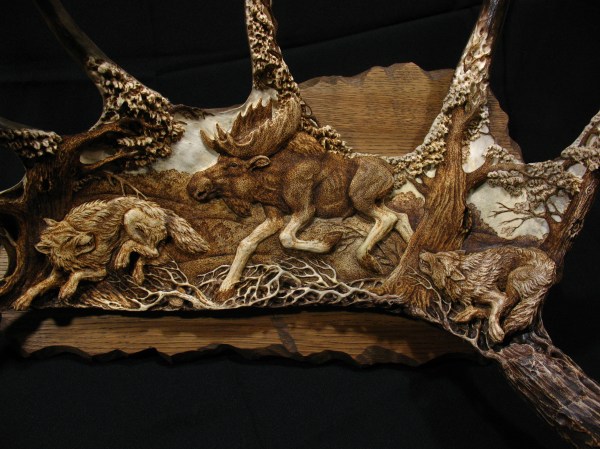**UPDATED – Recent work, Dec 2016 (see galleries at end of article)**
(Dmitry’s responses translated from Russian by Elena Nikolaenko)
1. Tell me a little about yourself: Where did you grow up? Where do you live now and what is it like? What kind of work or interests do you have outside of carving? I was born and currently live in Bryansk, quite a big town in Central Russia not far from Moscow. A town with quite a long and rich historical heritage, much of which is being restored now. Arts and crafts are becoming more popular nowadays in Russia, but not that much yet and people do not treat them seriously. They do not treat the profession of an artist seriously and that is why the cultural marketplace is not so well developed and artists need to struggle to develop their art and to survive. This of course influences the whole situation about arts in Russia. In spite of this, carving is both my profession and my hobby; I do not have any other jobs. My main interest outside of carving? Mountain biking!
2. How did you become interested in art? Do you have any formal or informal art training or apprenticeships? Who are your mentors or teachers and what do you appreciate about their work? What attracted you to the idea of making sculpture? As a child I liked to draw and paint; sciences were of little interest for me at school. I developed an interest in carving as a boy watching on of my father’s colleagues carve a wooden figure of a sea animal. After that I tried my hand at it too. I started carving seriously at the Art Institute, Bryansk, Russia, from which I graduated with the qualifications of a Master-Artist of Applied Art and Folk Crafts (1998). I was lucky to have a kind of apprenticeship outside classroom with a local wood carver, Orlov Igor, who taught me many practical and basic things and in whose workshop I spent many hours. I currently have a good advisor and friend, one of the former professors from the Art Institute, Alexander Bodyakov. He is retired and teaches no more, but carves commissions for the Church. I find his deep knowledge of the arts helps me a lot. I started by carving wood and only after that, bone. The latter attracts me more as it allows greater freedom of treatment of the material. I am attracted to sculpture because it is the most complex, difficult and all-embracing of the arts: you need to know anatomy, the movements typical of this or that animal, the texture and qualities of the materials used, the instruments needed to carve each different material, etc. The impression produced by sculpture is great and many-sided.
3. How did you become interested in antler as a carving medium? Do you have specific training or mentoring for antler carving? You sometimes combine antler with wood, do you carve other materials as well? I started carving moose antlers after graduating from the Art Institute. I was in search of the materials with which I would mostly like to work (I even had some experience working as a painter for several months with the designer’s studio “Atelier Benoni”, Prague, the Czech Republic in 2005) and one day I met a taxidermist, here in Bryansk, who simply asked me, “Why not try carving antlers?” I agreed and so he commissioned my first antler carving. Though I worked hard at it, the carving was a failure, in my opinion! I found working with perspective on the moose antler and understanding the anatomy of dogs and wolves was quite difficult (see images 1,2). We did not have any selective courses on carving antler, bone or the like at the Art Institute, so I learned it on my own by consulting both local carvers, who had experience carving bone, and people in specialized on-line forums. Also, I read books on the subject and experimented on my own. In addition to antler and wood, I also carve mammoth, walrus and sperm-whale tusks, ivory and rhino-horn. I prefer carving mammoth tusk, as it allows me to create minute details and looks quite beautiful with its delicate texture and colour.
4. Can you tell me about your studio set up and the tools you use? Where do you get your material (antler, ivory, etc.)? My studio is just two medium-sized rooms, one is equipped with a long table, a big Metabo saw, a couple of Dremel and Micro NX tools, some chisels. This is where I work. In the other room, I store antlers and other materials and also keep a high stand to make the preliminary models of my sculpture from modeling clay (plasticine). I buy antlers mostly from people who live in the country and find shed antlers in forests (they are plentiful in the northern, Karelia region). They are shipped to me by post. In case of expensive materials, like mammoth tusk, they are usually provided by the person who commissions the work.
5. What kind of animals do you carve and what meaning do they have for you? Do you carve other subjects as well? What are you working on now? As a wildlife carver, I carve scenes from forest life. I also carve scenes from hunting life too. I have a lot of experience carving dogs, wolves, moose, bears, wild boars, and deer. (see images 3-7a,b)
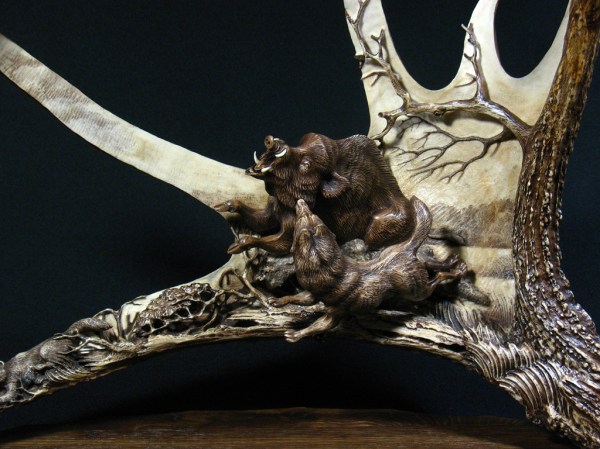
7a. Wild Boar and Laika – 2 by Dmitry Gorodetsky (carved and stained moose antler and wood – 45cm x 25cm)
The selection of the animals I carve is dictated by my location I think; these ones are typical of Russian forests. Since childhood, I have seen pictures of them in books, wildlife documentaries, etc. However, dogs and wolves are my favourites. I have always had dogs in the house, so it helps me in my work. I know their behaviour, anatomy and movement and can “ask” my dog to be my “subject” for a couple of minutes: turning his head this way or that, moving his legs to see how the joints work, etc. I have often carved the Russian hunting breed of ‘laikas’ (the name literally means ‘barker’ – images 1,2 and 7a) and have just finished working on a carving of the ‘borzois’ (a Russian wolfhound, whose name literally means ‘fast’ – image 7b) , also a famous hunting breed in Russia. The two breeds have completely different physical characteristics and ways in which they move.
Wolves are also canines and the fact that they are wild animals, unspoilt by civilization, I find very attractive. In addition, I find the knowledge about this animal fascinating: the way they live and behave. People have always thought about them as cruel, wicked and blood-thirsty predators, but few really know how amazing the way of life is within a wolf pack. (see images 8-11)
In terms of other subjects, I had a commission carving Chinese vases once and found it to my taste. The subject matter was very peaceful and calming – lotus flowers and other plants, birds, crabs. I also like carving Orthodox scenes, used for decorating the mitra (religious objects). To carve these seriously, one should be imbued with a believing spirit and do it for the true Church and its people, not just because religious themes are popular and can earn you a lot of money. (see images 12-14)
Right now I am working on both a new moose antler carving and carving a large wolf pack on a good-sized mammoth tusk (70 cm long). It is proving quite a challenge, since the subject is rather complicated – but the material is worth it!
6. How do you go about creating a sculpture? How do you decide when you’ll make a carving in the antler alone or combine it with a wood element? Tell me about your carving process: planning, stages, tool/carving techniques (favourites tools?). How do you finish the sculpture: sanding, stain, varnish, mounting?
All starts with an idea. I have a moose antler (or any other material) before my eyes and the antler “prompts” the subject I’ll carve by the antler’s form, curved lines, colour and texture. Then as soon as I see the composition I make sketches on paper, playing with animal’s movements, body positions, and the arrangement of the animals on the antler. It is difficult to say HOW I decide to carve an antler with a wood sculpture or without it. I think it depends on the way I see the scene on the antler; I feel at once, “Oh, yes, this spot is perfect for a wooden figure, which will go very well with the animals made in relief”. Something of the sort.

Phase 1 – The moose antler background is roughed out. (Dmitry Gorodetsky mixed media moose antler sculpture, in progress)
The carving itself takes quite a lot of time; I pay a lot of attention to details and forms. It can’t be finished in one day. I put the work aside for a time in order to gain a fresh perspective on the carving. Looking at it later, with a fresh eye and under different light, I am able to bring it to the finished stage.
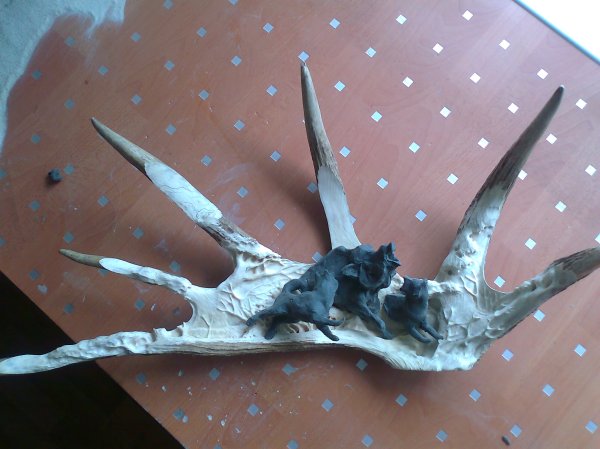
Phase 2 – The figures are modelled in plastercine and fitted to the moose antler background, prior to being carved in wood. (Dmitry Gorodetsky mixed media moose antler sculpture, in progress)
I use different techniques working at a moose antler, even several different ones can be applied on one moose antler in combination. Among them are: relief carving, cut carving, using a burning tool, staining, adding extra wooden sculptures. Each has its peculiarities and nuances: Cut carving makes the work airy and light and exquisite in case you find a good wide moose antler and good composition. Relief carving is hard work, as a relief should look natural whatever angle you look at it, whatever the light is, etc. You really need to know about bass-relief and high relief.

Phase 3 – The first figure, a laika, is roughed out in wood and further detail of trees and bushes are added to the moose antler background. (Dmitry Gorodetsky mixed media moose antler sculpture, in progress)

Phase 4 – The two laikas are refined and the wild boar is roughed out in wood. Further detail of trees and bushes are added to the moose antler background. (Dmitry Gorodetsky mixed media moose antler sculpture, in progress)

Phase 5 – The two laikas wild boar are attached to the moose antler background. (Dmitry Gorodetsky mixed media moose antler sculpture, in progress)
Staining is of course a problem, even a dilemma sometimes, as the colours you get depend on the bone texture and the relief carving itself. It is difficult to stain moose antler, because each antler has a variety of porous and less porous areas. The porous areas can soak up too much of the stain and create dark spots, the colour lying unevenly over the antler surface.

6. Final Phase – The wood figures and moose antler background details have been refined. A stain has been applied selectively to bring out the carved detail. Note, some of the background has been left unstained in contrast, to create an effect of depth. Wild Boar and Laikas, by Dmitry Gorodetsky (carved and stained moose antler and wood – 60cm x 32cm)
Mammoth tusk can turn unexpected shades when stained too! Once, when staining the mammoth tusk carving (see image 17) in the same way as I had done with another carving before, it became a strange green-brown colour. I was shocked, thinking the work marred and spoilt, but after polishing it acquired a nice, antique coloration. There is quite a lot of information out there on natural and chemical substances that can be used for staining, as carving bone has quite a long and rich history, but it is important to note that each piece may react uniquely.
After staining, polishing can be applied, again, depending on the effect you want to have: polished things can seem more finished and have a more – so to say – “suitable for purchase” appearance. But sometimes a matte surface is more preferable as more natural. Using a burning tool makes the antler texture look peculiar and interesting, like having tiny dots on the surface, but it demands practice in determining the degree of heat to apply. This process is quite slow and very demanding. (see image 16)
I make wood bases for my carvings and like to use oak because of its texture. The base should match the antler in size and form; it can also have some carved elements on it but they shouldn’t be in excess, just a necessary addition to the carving to heighten the effect. As for a favourite tool, I like to use all of them, perhaps with just one preference: a 0.3mm burr and my Micro NX machine!
7. How do you market your work? Is it made ‘on spec’ for sale in a gallery, or do you work by commission? Where do you sell your work? How do you handle the logistics of selling to people in other countries (money, shipping, export/import, etc.)? I have my web site (http://carving-studio.com), post images of my carvings in various online forums (art, carving, hunting and taxidermy), and in online art galleries (Russian). Up to now I have made carvings by commission – people have come to know me through these resources. I am planning to take part in serious exhibitions; the preparation requires much time and effort, but it is a must-do, I think. I have never sold any work via Internet – many people write and ask about the way to buy the carvings but as soon as it comes to the shipping and paying question, they strangely disappear. Fortunately, not so long ago, international payments became much easier here. PayPal works for both sending and receiving funds from Russia.
8. What plans do you have for creating sculpture in the future? Thing number one which is now in my mind is to hold a personal exhibition for which to prepare a variety of compositions made in moose antler, mammoth tusk and other materials, devoted to wildlife. And in general it is to work hard, as making sculpture is an art which requires constant and continuous development of artistic skills and knowledge.
DMITRY GORODETSKY – IMAGE GALLERY OF RECENT WORK
Moose and Wolves (mammoth tusk) by Dmitry Gorodetsky
Boar and Wolf (mammoth tusk) by Dmitry Gorodetsky
Wolf and Deer Knife (mammoth ivory) by Dmitry Gorodetsky
